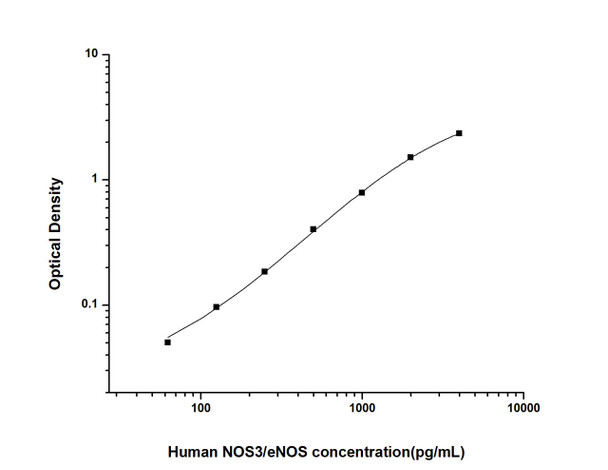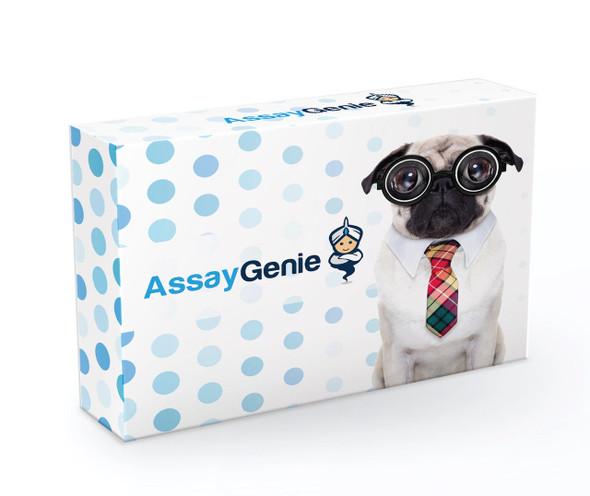Human Cell Biology ELISA Kits 2
Human NOS3/eNOS (Nitric Oxide Synthase 3, Endothelial) ELISA Kit (HUES01899)
- SKU:
- HUES01899
- Product Type:
- ELISA Kit
- Size:
- 96 Assays
- Uniprot:
- P29474
- Sensitivity:
- 37.5pg/mL
- Range:
- 62.5-4000pg/mL
- ELISA Type:
- Sandwich
- Synonyms:
- ECNOS, NOS III, E-NOS
- Reactivity:
- Human
- Sample Type:
- Serum, plasma and other biological fluids
- Research Area:
- Cell Biology
Description
| Assay type: | Sandwich |
| Format: | 96T |
| Assay time: | 4.5h |
| Reactivity: | Human |
| Detection Method: | Colormetric |
| Detection Range: | 62.50-4000 pg/mL |
| Sensitivity: | 37.50 pg/mL |
| Sample Volume Required Per Well: | 100µL |
| Sample Type: | Serum, plasma and other biological fluids |
| Specificity: | This kit recognizes Human NOS3/eNOS in samples. No significant cross-reactivity or interference between Human NOS3/eNOS and analogues was observed. |
This ELISA kit uses Sandwich-ELISA as the method. The micro ELISA plate provided in this kit has been pre-coated with an antibody specific to Human NOS3/eNOS. Standards or samples are added to the appropriate micro ELISA plate wells and combined with the specific antibody. Then a biotinylated detection antibody specific for Human NOS3/eNOS and Avidin-Horseradish Peroxidase (HRP) conjugate are added to each micro plate well successively and incubated. Free components are washed away. The substrate solution is added to each well. Only those wells that contain Human NOS3/eNOS, biotinylated detection antibody and Avidin-HRP conjugate will appear blue in color. The enzyme-substrate reaction is terminated by adding Stop Solution and the color turns yellow. The optical density (OD) is measured spectrophotometrically at a wavelength of 450 nm ± 2 nm. The OD value is proportional to the concentration of Human NOS3/eNOS. The concentration of Human NOS3/eNOS in samples can be calculated by comparing the OD of the samples to the standard curve.
| UniProt Protein Function: | eNOS: endothelial constitutive nitric oxide synthase. Synthesizes nitric oxide (NO) from arginine and oxygen, which is implicated in vascular smooth muscle relaxation through a cGMP-mediated signal transduction pathway. NO mediates vascular endothelial growth factor (VEGF)-induced angiogenesis in coronary vessels and promotes blood clotting through the activation of platelets. Induced in humans by caloric restriction. Stimulated by calcium/calmodulin. Inhibited by NOSIP and NOSTRIN. |
| UniProt Protein Details: | Protein type:Amino Acid Metabolism - arginine and proline; Oxidoreductase; EC 1. 14. 13. 39 Chromosomal Location of Human Ortholog: 7q36 Cellular Component: caveola; cytoplasm; cytoskeleton; cytosol; Golgi membrane; nucleus; plasma membrane Molecular Function:actin monomer binding; cadmium ion binding; calmodulin binding; FAD binding; FMN binding; heme binding; iron ion binding; NADP binding; nitric-oxide synthase activity; protein binding Biological Process: angiogenesis; arginine catabolic process; blood coagulation; blood vessel remodeling; cell redox homeostasis; endothelial cell migration; in utero embryonic development; lipopolysaccharide-mediated signaling pathway; lung development; mitochondrion organization and biogenesis; negative regulation of blood pressure; negative regulation of calcium ion transport; negative regulation of cell proliferation; negative regulation of hydrolase activity; negative regulation of muscle hyperplasia; negative regulation of potassium ion transport; nitric oxide biosynthetic process; nitric oxide mediated signal transduction; nitric oxide metabolic process; ovulation from ovarian follicle; positive regulation of angiogenesis; positive regulation of guanylate cyclase activity; positive regulation of vasodilation; regulation of blood pressure; regulation of blood vessel size; regulation of nitric-oxide synthase activity; regulation of sodium ion transport; regulation of systemic arterial blood pressure by endothelin; regulation of the force of heart contraction by chemical signal; removal of superoxide radicals; response to heat; smooth muscle hyperplasia; vascular endothelial growth factor receptor signaling pathway Disease: Alzheimer Disease; Hypertension, Essential; Preeclampsia/eclampsia 1; Stroke, Ischemic |
| NCBI Summary: | Nitric oxide is a reactive free radical which acts as a biologic mediator in several processes, including neurotransmission and antimicrobial and antitumoral activities. Nitric oxide is synthesized from L-arginine by nitric oxide synthases. Variations in this gene are associated with susceptibility to coronary spasm. Multiple transcript variants encoding different isoforms have been found for this gene. [provided by RefSeq, May 2009] |
| UniProt Code: | P29474 |
| NCBI GenInfo Identifier: | 266648 |
| NCBI Gene ID: | 4846 |
| NCBI Accession: | P29474. 3 |
| UniProt Secondary Accession: | P29474,Q13662, Q14251, Q14434, Q548C1, Q6GSL5, Q9UDC6 A0S0A7, A0S0A8, A8KA63, B2RCQ1, E9PFR2, |
| UniProt Related Accession: | P29474 |
| Molecular Weight: | |
| NCBI Full Name: | Nitric oxide synthase, endothelial |
| NCBI Synonym Full Names: | nitric oxide synthase 3 |
| NCBI Official Symbol: | NOS3 |
| NCBI Official Synonym Symbols: | eNOS; ECNOS |
| NCBI Protein Information: | nitric oxide synthase, endothelial |
| UniProt Protein Name: | Nitric oxide synthase, endothelial |
| UniProt Synonym Protein Names: | Constitutive NOS; cNOS; EC-NOS; Endothelial NOS; eNOS; NOS type III; NOSIII |
| Protein Family: | Nitric oxide synthase |
| UniProt Gene Name: | NOS3 |
| UniProt Entry Name: | NOS3_HUMAN |
As the OD values of the standard curve may vary according to the conditions of the actual assay performance (e. g. operator, pipetting technique, washing technique or temperature effects), the operator should establish a standard curve for each test. Typical standard curve and data is provided below for reference only.
| Concentration (pg/mL) | O.D | Average | Corrected |
| 4000 | 2.409 2.443 | 2.426 | 2.349 |
| 2000 | 1.559 1.607 | 1.583 | 1.506 |
| 1000 | 0.867 0.861 | 0.864 | 0.787 |
| 500 | 0.464 0.496 | 0.48 | 0.403 |
| 250 | 0.267 0.255 | 0.261 | 0.184 |
| 125 | 0.178 0.168 | 0.173 | 0.096 |
| 62.50 | 0.125 0.129 | 0.127 | 0.05 |
| 0 | 0.076 0.078 | 0.077 | -- |
Precision
Intra-assay Precision (Precision within an assay): 3 samples with low, mid range and high level Human NOS3/eNOS were tested 20 times on one plate, respectively.
Inter-assay Precision (Precision between assays): 3 samples with low, mid range and high level Human NOS3/eNOS were tested on 3 different plates, 20 replicates in each plate.
| Intra-assay Precision | Inter-assay Precision | |||||
| Sample | 1 | 2 | 3 | 1 | 2 | 3 |
| n | 20 | 20 | 20 | 20 | 20 | 20 |
| Mean (pg/mL) | 186.70 | 451.70 | 1380.60 | 204.80 | 422.50 | 1440.90 |
| Standard deviation | 12.90 | 20.30 | 69.00 | 12.70 | 18.60 | 46.10 |
| C V (%) | 6.91 | 4.49 | 5.00 | 6.20 | 4.40 | 3.20 |
Recovery
The recovery of Human NOS3/eNOS spiked at three different levels in samples throughout the range of the assay was evaluated in various matrices.
| Sample Type | Range (%) | Average Recovery (%) |
| Serum (n=5) | 93-108 | 101 |
| EDTA plasma (n=5) | 94-106 | 99 |
| Cell culture media (n=5) | 92-104 | 98 |
Linearity
Samples were spiked with high concentrations of Human NOS3/eNOS and diluted with Reference Standard & Sample Diluent to produce samples with values within the range of the assay.
| Serum (n=5) | EDTA plasma (n=5) | Cell culture media (n=5) | ||
| 1:2 | Range (%) | 93-107 | 98-112 | 95-111 |
| Average (%) | 99 | 104 | 101 | |
| 1:4 | Range (%) | 98-115 | 88-101 | 97-114 |
| Average (%) | 106 | 93 | 104 | |
| 1:8 | Range (%) | 97-113 | 81-93 | 98-113 |
| Average (%) | 104 | 87 | 104 | |
| 1:16 | Range (%) | 98-111 | 83-95 | 90-106 |
| Average (%) | 104 | 88 | 98 |
An unopened kit can be stored at 4°C for 1 month. If the kit is not used within 1 month, store the items separately according to the following conditions once the kit is received.
| Item | Specifications | Storage |
| Micro ELISA Plate(Dismountable) | 8 wells ×12 strips | -20°C, 6 months |
| Reference Standard | 2 vials | |
| Concentrated Biotinylated Detection Ab (100×) | 1 vial, 120 µL | |
| Concentrated HRP Conjugate (100×) | 1 vial, 120 µL | -20°C(shading light), 6 months |
| Reference Standard & Sample Diluent | 1 vial, 20 mL | 4°C, 6 months |
| Biotinylated Detection Ab Diluent | 1 vial, 14 mL | |
| HRP Conjugate Diluent | 1 vial, 14 mL | |
| Concentrated Wash Buffer (25×) | 1 vial, 30 mL | |
| Substrate Reagent | 1 vial, 10 mL | 4°C(shading light) |
| Stop Solution | 1 vial, 10 mL | 4°C |
| Plate Sealer | 5 pieces | |
| Product Description | 1 copy | |
| Certificate of Analysis | 1 copy |
- Set standard, test sample and control (zero) wells on the pre-coated plate and record theirpositions. It is recommended to measure each standard and sample in duplicate. Note: addall solutions to the bottom of the plate wells while avoiding contact with the well walls. Ensuresolutions do not foam when adding to the wells.
- Aliquot 100 µL of standard solutions into the standard wells.
- Add 100 µL of Sample / Standard dilution buffer into the control (zero) well.
- Add 100 µL of properly diluted sample (serum, plasma, tissue homogenates and otherbiological fluids) into test sample wells.
- Cover the plate with the sealer provided in the kit and incubate for 90 min at 37 °C.
- Aspirate the liquid from each well, do not wash. Immediately add 100 µL of BiotinylatedDetection Ab working solution to each well. Cover the plate with a plate seal and gently mix. Incubate for 1 hour at 37 °C.
- Aspirate or decant the solution from the plate and add 350 µL of wash buffer to each welland incubate for 1-2 minutes at room temperature. Aspirate the solution from each well andclap the plate on absorbent filter paper to dry. Repeat this process 3 times. Note: a microplatewasher can be used in this step and other wash steps.
- Add 100 µL of HRP Conjugate working solution to each well. Cover with a plate seal andincubate for 30 min at 37 °C.
- Aspirate or decant the solution from each well. Repeat the wash process for five times asconducted in step 7.
- Add 90 µL of Substrate Reagent to each well. Cover with a new plate seal and incubate forapproximately 15 min at 37 °C. Protect the plate from light. Note: the reaction time can beshortened or extended according to the actual color change, but not by more than 30min.
- Add 50 µL of Stop Solution to each well. Note: Adding the stop solution should be done inthe same order as the substrate solution.
- Determine the optical density (OD value) of each well immediately with a microplate readerset at 450 nm.






